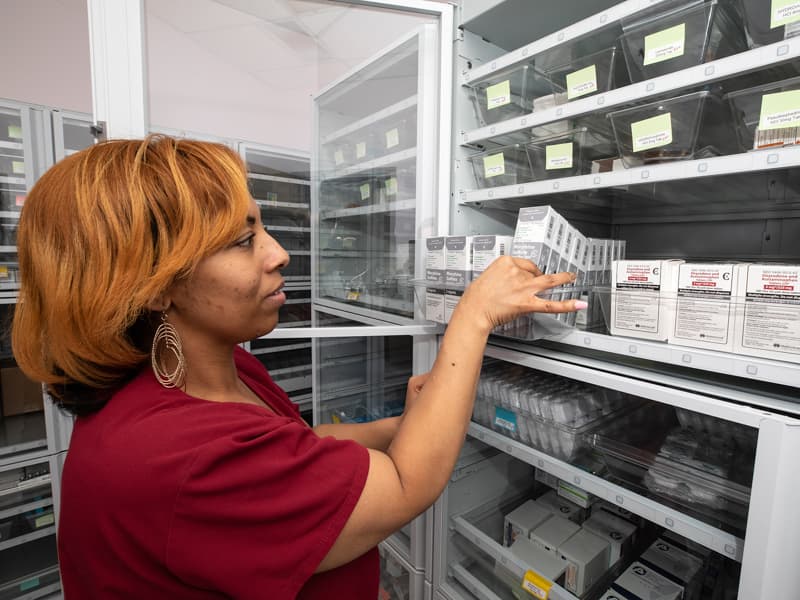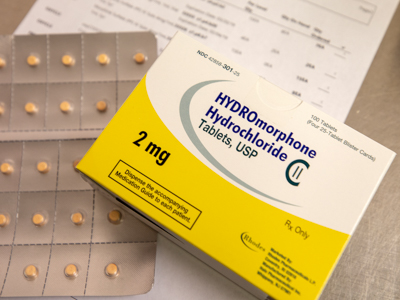UMMC Opioid Task Force gives providers tools to manage pain

University of Mississippi Medical Center providers have a drug test that doesn’t just meet new requirements for detecting controlled substances, it also screens for several other hard-to-detect compounds such as Fentanyl, an opioid up to 100 times more powerful than morphine.
Patients in the Medical Center’s Emergency Department who show signs of opioid withdrawal can start their recovery process immediately when ED staff connect them to UMMC’s addictions clinic.
And, providers are reaching across the aisle to have conversations with each other on whether their patient’s illness requires opioids, or in the alternative, a non-opioid medication or non-medication therapy.
It’s all part of the initial work of the Medical Center’s opioid task force, created in June 2018 to give providers the tools to take an even-handed approach to opioid prescribing, but at the same time deliver individualized care for every patient.
“We are trying to give a consistent message: Be cautious about opioid and controlled substance prescribing, but have a balanced approach and give patient-centered care,” said task force chair Dr. Ann Kemp, professor of family medicine. Her task force vice chair is Dr. William Gusa, assistant professor of anesthesiology.
The 37-member panel was established by Dr. LouAnn Woodward, vice chancellor for health affairs and dean of the School of Medicine. Task force members are giving guidance to both providers and learners through timely information and clarity on an issue that in 2017 saw more than 3.3 million opioid prescriptions dispensed in Mississippi.

The work of the task force is ongoing, but initial recommendations and actions have been crafted by four subcommittees: Guidelines, chaired by Dr. Molly Clark, associate professor of family medicine; Resources and Services, Dr. Jeff Parker, professor of psychiatry; Education, Dr. Sajani Tipnis, professor of pediatrics and neonatology; and Research, Dr. James Rowlett, professor of psychiatry.
Much of its work goes hand-in-hand with recommendations on opioid prescribing and monitoring issued late last year by the Mississippi State Board of Medical Licensure. Tipnis and her committee have condensed the key MSBML opioid regulations onto a card that providers can use as a daily resource. “It’s very compact – just the essential, main points,” Kemp said.
The card’s tips:
- Use caution when prescribing opioids or benzodiazepines. Prescribe the lowest effective dose.
- MSBML recommends that the lowest effective dose of opioids for acute pain is less than three days, but states it can be for no more than 10 days at a time. If it’s clinically indicated, a provider can document and write an additional three- to 10-day opioid prescription. For non-cancerous, non-terminal chronic pain, the lowest effective dose is recommended to be less than or equal to 50 morphine milligram equivalents, MME for short, daily; avoid prescribing more than 90 MME daily if possible. If a patient needs more than 100 MME daily, they should be referred to a pain management provider.
- Review the patient’s record in the state’s Prescription Monitoring Program before writing an outpatient opioid and benzodiazepine prescription, and document that you reviewed the PMP in the patient’s chart.
- Document the PMP review upon any initial controlled substance prescription other than opioids and at least every three months thereafter. Exceptions are the drugs Lomotil®, Lyrica®, testosterone, pseudoephedrine, and amphetamines for patients under age 16.
- Order point of service drug testing three times per year if prescribing Schedule II opioids for chronic non-cancerous or non-terminal pain, or if prescribing benzodiazepines for chronic psychiatric or medication conditions.
“We’ve found that some of our providers think that the new Board of Licensure recommendations mean that they can’t prescribe controlled substances anymore,” Kemp said. “That’s not the case. Providers need to make the best medical decisions for their patients, and then to document it appropriately in the patient’s record.”

“It’s not just about the prescriptions,” Gusa said. “It’s the appropriateness. That’s harder to quantify.”
Not just UMMC providers, but providers statewide are experiencing “confusion and anxiety” over the new regulations, said MSBML president Dr. Claude Brunson, UMMC professor of anesthesiology and senior advisor to the vice chancellor.
Such misunderstandings underscore the need to educate providers and learners and answer their questions, Gusa and Kemp say.
“We’ve developed a speakers’ pool within the task force,” Kemp said. “We will come to your department, division or residents’ meetings and talk about the regulations and tips for implementation.”
The task force is spawning collaborations between departments. Among them: A new drug compliance test, dubbed “Lab 6696,” is now available in Epic for use by any provider. “It flips the logic of what previous drug screens did by testing for medications that the patient actually should be on,” Kemp said, in addition to other opioids such as potentially fatal Fentanyl.
The Department of Psychiatry and Human Behavior in fall 2017 created a first-ever, comprehensive drug addictions program and clinic at the Medical Center. The clinic team includes Dr. Saurabh Bhardwaj, an addiction psychiatrist who sees patients for opioid use disorder at the Behavioral Health Specialty Clinic in the Jackson Medical Mall.

“The growth of the addictions program and the work of the task force have operated in concert with each other,” Parker said. “We’ve created a new referral in Epic that specifically directs ED patients to our addiction services. Because of the ability to refer, the ED has been able to have them seen in our clinic very promptly so that they can have a continuity of care. And, it’s not just for the ED. Any department can use this referral.”
If a provider is concerned that a patient is developing, or has developed, a substance use disorder of any kind, they’re encouraged to consult with the addiction services team, Gusa said. The solutions could include medication-assisted treatment, which calls for giving the appropriate patients drugs that reduce cravings for opioids and prevent addicts from getting high if they relapse.
“The comprehensive approach the opioid task force has taken regarding the opioid problem has led to some sound solutions that will help our providers safely treat their patients,” Brunson said. “Their work can become a template to be utilized by providers across the state, and I hope that it will.”


